Living in a drought-prone area can make gardening difficult. Droughts can be cyclical and hit the same place more than once or twice a year, making it challenging to maintain lush and thriving greenery in areas affected by dry spells. But what happens when you have a dry spell, and you have a mostly shady garden area?
If you live in a dry area and have shady garden spaces, it’s time to find some drought tolerant plants that don’t require a lot of sun. It might seem like these plants may not exist, but there are plenty of different options, depending on your local climate. The best part is that most of these plants will require less attention and maintenance than plants that need more water and all-day sunshine.
If you’re struggling to coax your annuals and perennials to life, these drought tolerant shade plants are worth consideration. Ready to learn more? Let’s take a look at our favorite plants that will grow perfectly in shaded, dry climates!
Autumn Brilliance Fern
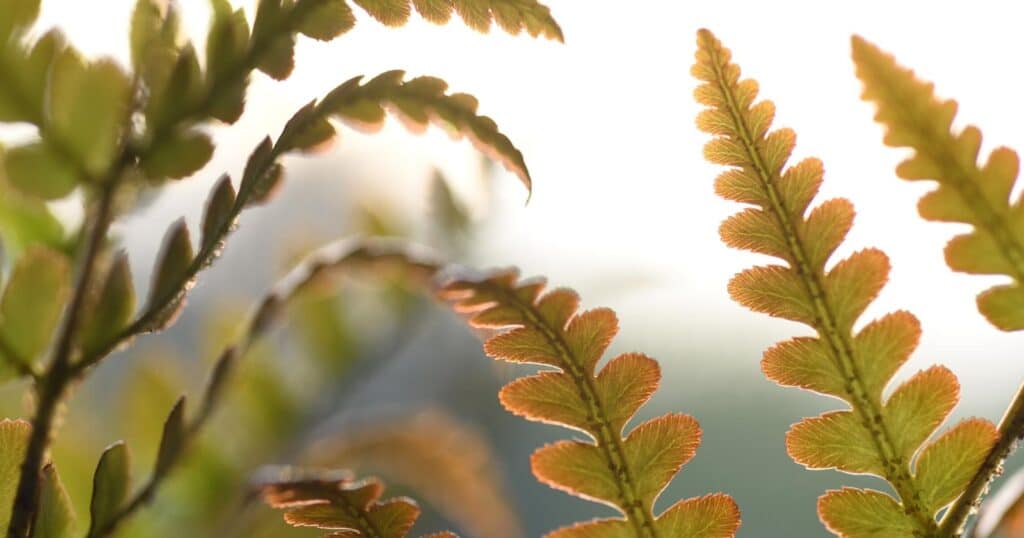
Scientific Name: Dryopteris erythrosora ‘Brilliance’
- Plant Type: Semi-evergreen
- Origin: China and Japan
- Size: 12-28 inches
- Sun Needs: Full Shade-Partial Shade
- Hardiness Zones: 4 Through 9
Despite its relatively small size compared to other ferns, Autumn Brilliance is a treat for gardeners who desire a drought-tolerant shade plant that maintains color year-round in the right conditions.
When they first sprout, Dryopteris erythrosora ‘Brilliance’ puts forth shining orange leaves that slowly transform into a glossy, deep green as the plant matures.
These ferns are highly resistant to critters, including deer and rabbits, making for an attractive yet hardy addition along edges, as cut foliage, and in porch-top containers.
Bear’s Breeches
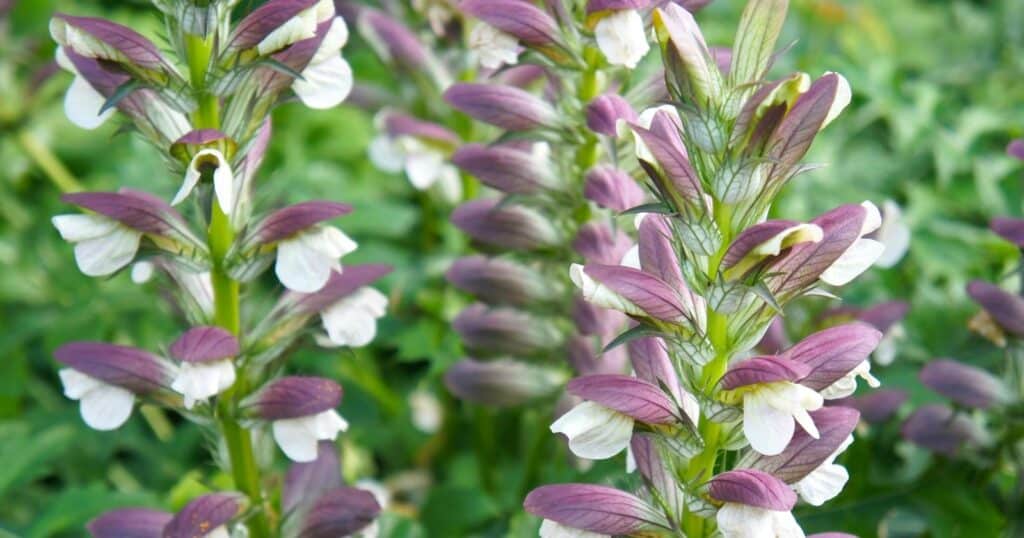
Scientific Name: Acanthus mollis
- Plant Type: Perennial
- Origin: Europe and the Mediterranean
- Size: 6 Feet
- Sun Needs: Partial Shade
- Hardiness Zones: 6 Through 10
A Bear’s Breeches plant has tall stalks that can grow up to six feet tall and has velvety, glossy leaves and spikes with flowers. Due to their beauty, they are the subject of many artworks, paintings, jewelry, and other pieces.
A Bear’s Breeches plant is also called an oyster plant and thrives in partial shade. It does best in nutrient-rich soil that has good drainage.
After seedlings have established their roots, Bear’s Breeches are tough and will do best with regular water but do not need much water to thrive.
Bigroot Geranium
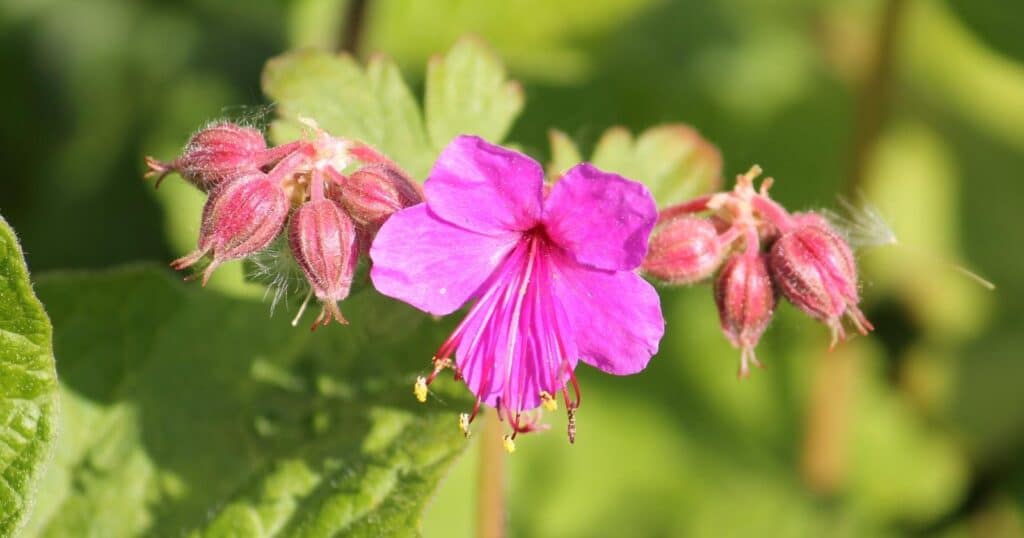
Scientific Name: Geranium macrorrhizum
- Plant Type: Perennial
- Origin: Balkans and the Alps
- Size: 12 Inches
- Sun Needs: Partial Shade
- Hardiness Zones: 3 Through 8
Bigroot Geranium plants are ideal for any front lawn or garden in dry or drought-prone areas. Once established, Bigroot Geranium plants will thrive on little water and partial shade.
The leaves on this plant look like snowflakes and have a fuzzy exterior to the touch. Deer and rabbits do not like plants with fuzzy leaves, making this plant ideal for areas where rabbits and deer are a common problem.
Bigroot Geranium is a perennial and thus will change colors as the autumn comes. The reddish-orange tinge of the leaves in the fall is a selling point for many at-home gardeners.
Bishop’s Hat
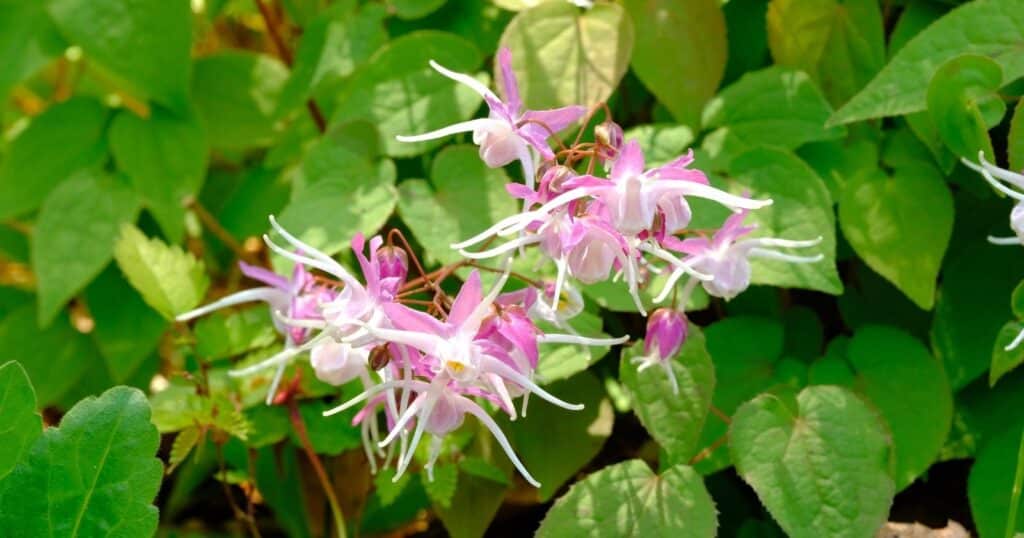
Scientific Name: Epimedium grandiflorum
- Plant Type: Perennial
- Origin: China
- Size: 12 Inches
- Sun Needs: Partial Shade
- Hardiness Zones: 7 Through 10
A Bishop’s Hat plant, or barrenwort, is ideal for offering ground cover and shade for a garden or common area. This plant enjoys well-drained and acidic soil.
Once established, Epimedium grandiflorium produces small purple, pink, or white flowers that sit jauntily above the foliage on dainty stems.
Many home gardeners will enjoy a Bishop’s Hat plant in their rock gardens, shaded borders of the home and lawn, or wooded areas of the property. These plants can also line a sidewalk or walkway for a vibrant feel.
Bleeding Heart
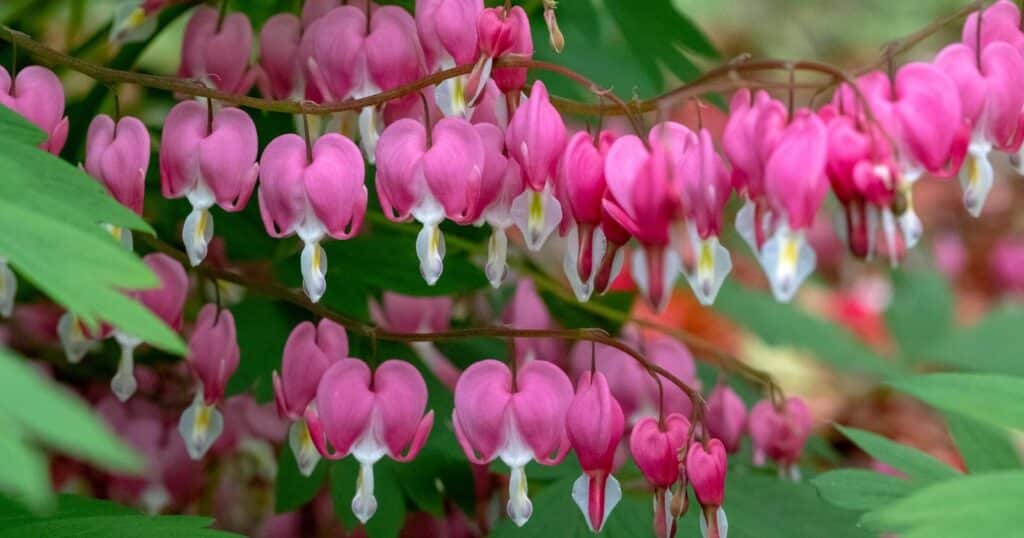
Scientific Name: Dicentra spectabilis
- Plant Type: Perennial
- Origin: China and Japan
- Size: 36 Inches
- Sun Needs: Light Shade
- Hardiness Zones: 3 Through 9
The Bleeding Heart plant is a unique and drought tolerant plant that hails from China and Japan. These plants offer pinkish and reddish heart-shaped flowers on a vining branch. These flowers hang downward and bloom blue and green foliage from the bottom of their heart shape.
A Bleeding Heart plant is drought tolerant when strong but will benefit from mixing compost into its soil. It will also do better with plant food.
Dicentra spectabilis will die during summer but regrow as cooler temperatures creep in. Although this plant withers in the summer, it does prefer dry conditions.
Columbine
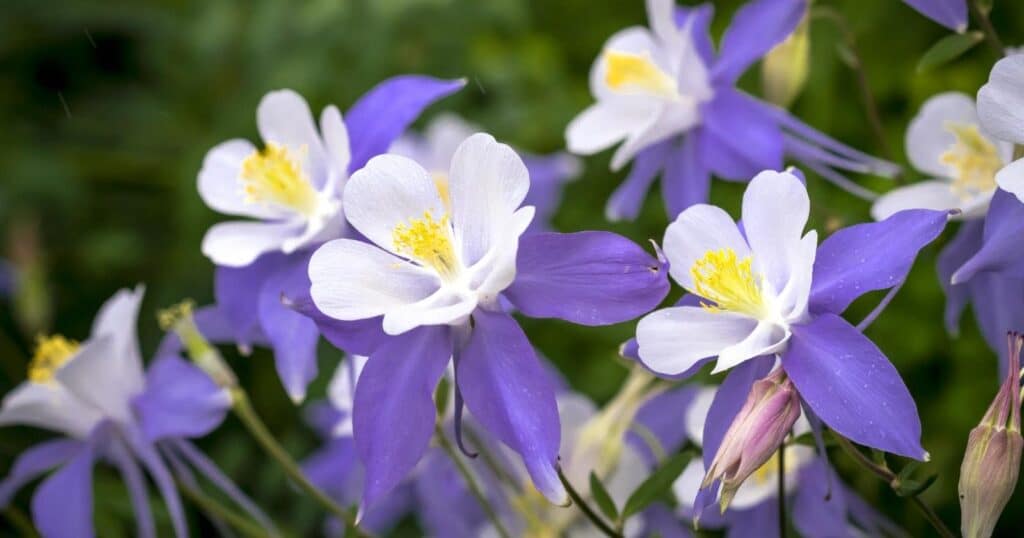
Scientific Name: Aquilegia
- Plant Type: Perennial
- Origin: Europe and North America
- Size: 3 Feet
- Sun Needs: Partial Shade
- Hardiness Zones: 3 Through 9
There are about 100 species of Columbine plants, and these varieties are found all over Europe and North America. Wild Columbine plants grow in forests, woods, and rocky areas extending to Canada.
These plants are plentiful in the Rocky Mountains and often naturally crossbreed, leading to many wild hybrids.
A Columbine has flowers with five petals, some going backward toward the foliage and leaves below. These petals feature pouches that contain nectar and are attractive to bees and other insects.
Coral Bells
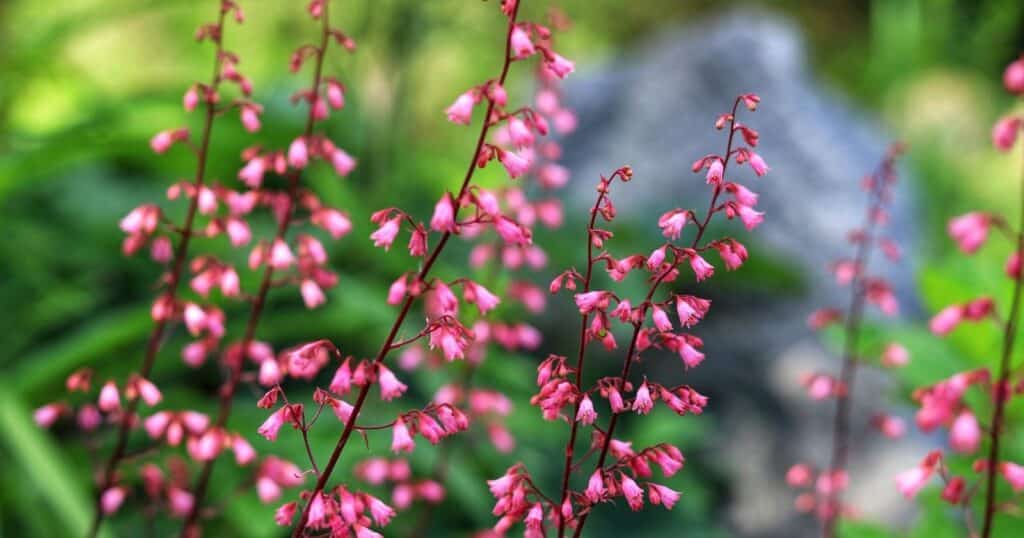
Scientific Name: Heuchera sanguinea
- Plant Type: Perennial
- Origin: Mexico
- Size: 16 Inches
- Sun Needs: Partial Shade
- Hardiness Zones: 4 Through 9
A Coral Bells plant grows in nutrient-rich soil, producing purple, reddish, green, orange, and yellow foliage. The flowers of this plant loom high above the foliage below.
The flowers are usually a pink or dark purple color and sit high above the base of the leaves, which work to keep the roots insulated and protected from the sun.
Coral Bells is ideal for walkways, sidewalks, and rock gardens.
Creeping Oregon Grape
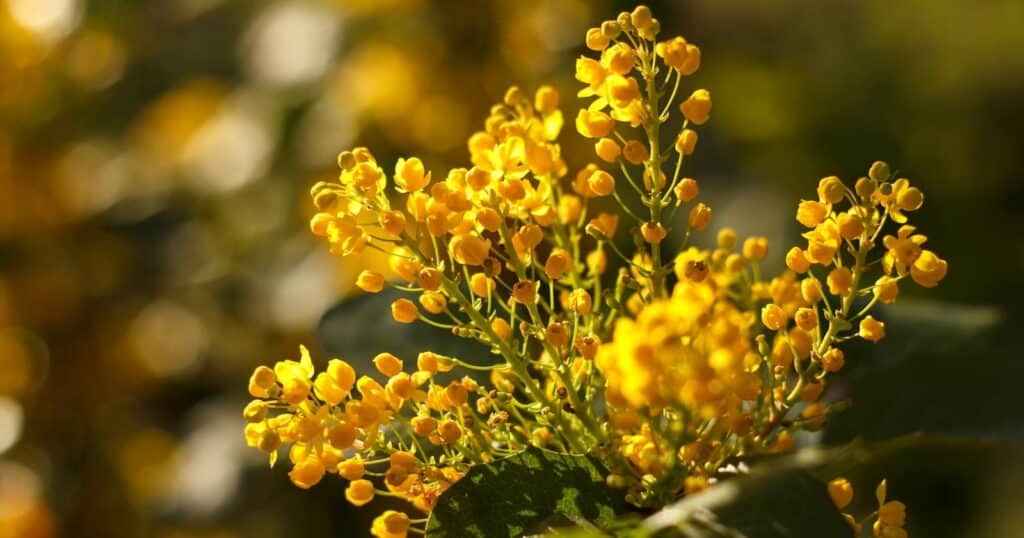
Scientific Name: Mahonia repens
- Plant Type: Perennial
- Origin: North America
- Size: 10 Feet
- Sun Needs: Full Sun – Full Shade
- Hardiness Zones: 5 Through 8
A Creeping Oregon Grape is a colorful shrub often found in a shady area or creeping over rocks. This plant – and the flower it grows – is the state flower in Oregon.
It’s named for its edible, grape-like fruit, but the bitter taste isn’t appealing for human consumption.
Mahonia repens provide an entire palette of colors for each season, shifting between green, yellow, purple, or blue.
Creeping Oregon Grape grows ten feet high and covers as many as five feet of ground cover. This plant may take a long time to mature but accelerates its growth as it gets older.
Deadnettle
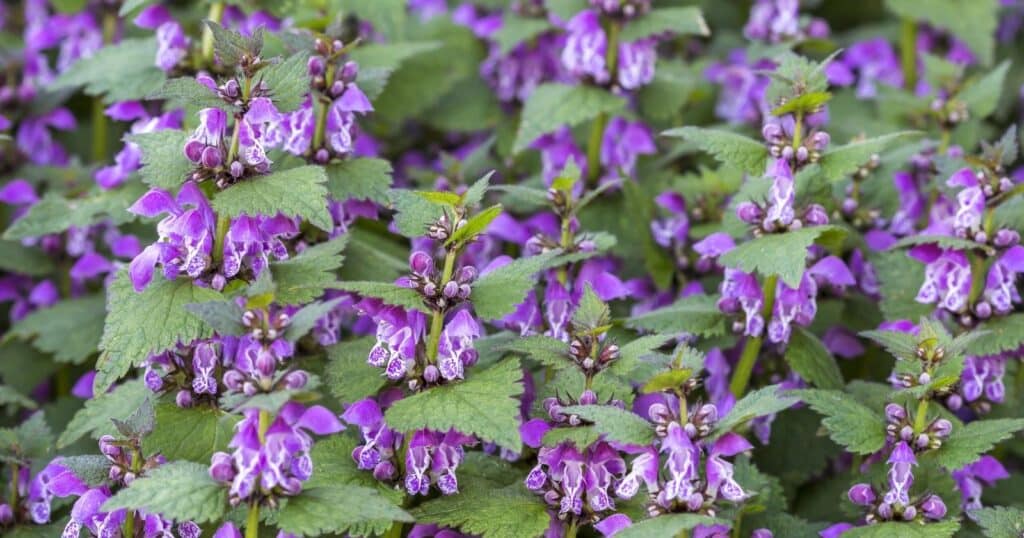
Scientific Name: Lamium purpureum
- Plant Type: Perennial
- Origin: Europe and Asia
- Size: 12 Inches
- Sun Needs: Partial Shade
- Hardiness Zones: 4 Through 10
Deadnettle is a unique, edible weed that gardeners enjoy for its vibrant color and minty taste.
This plant grows multiple stalks that stand proud and erect, the stalks a deep green color and a purple set of leaves topping the branch.
This plant can grow multiple stalks in one plant and blooms several purple flowers in each spike.
In the past, Deadnettle was a prized medicinal plant, hailed as a diuretic and anti-inflammatory. It also has antifungal and antibacterial properties.
English Ivy
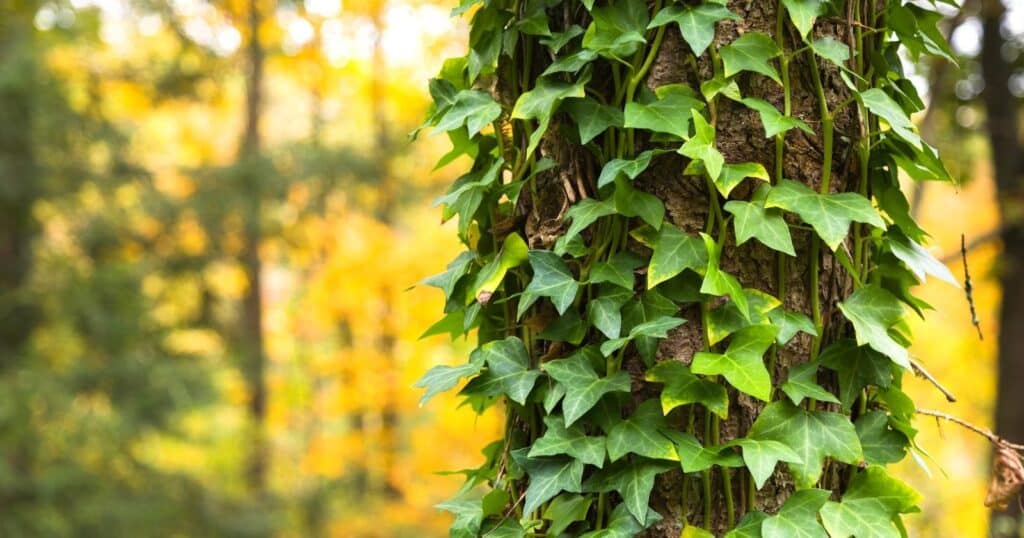
Scientific Name: Hedra helix
- Plant Type: Perennial
- Origin: Europe, Asia, and Africa
- Size: 8 Inches
- Sun Needs: Full Sun – Partial Shade
- Hardiness Zones: 4 Through 13
English Ivy has a rich horticultural history, being used widely for groundcover and ornamental design in Europe during the 1700s. It produces glossy, deep green leaves that maintain their color despite the season.
This classic climber can give plenty of shade and coverage when used on a pergola or overhead trellises. English Ivy can cover several tens of feet of space with something to climb.
Without the addition of a trellis or cage, English Ivy only achieves a height of around 8-inches.
Be aware that the Hedra helix is also an invasive species that can destroy other plants and cause them to wither and die.
Foamflower
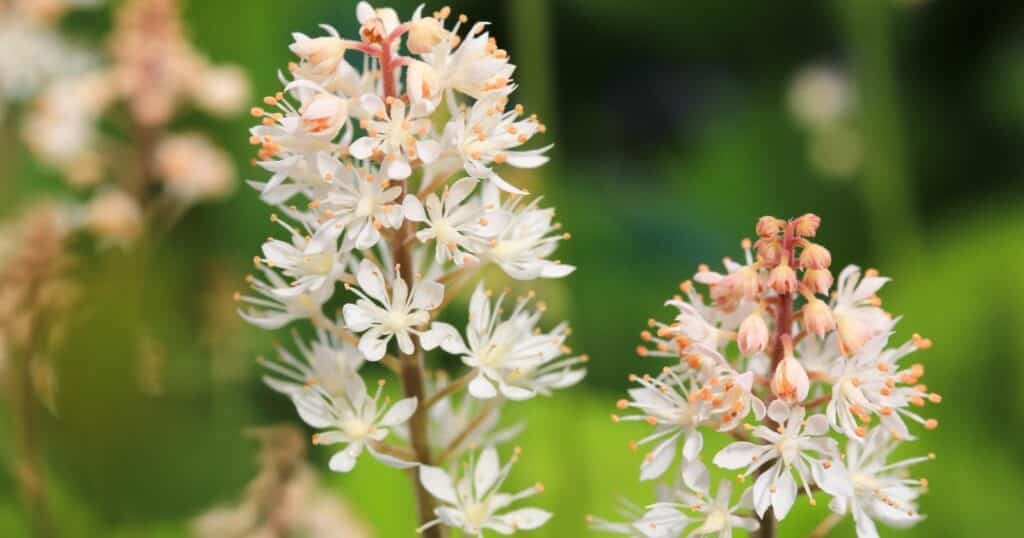
Scientific Name: Tiarella cordifolia
- Plant Type: Perennial
- Origin: North America
- Size: 12 Inches
- Sun Needs: Partial Sun
- Hardiness Zones: 4 Through 7
A Foamflower plant is a native wildflower that forms a mass of white and pink flowers on long stems. This plant is ideal for ground cover and can be incorporated into dry, shady beds without much trouble.
Tiarella cordifolia will require well-draining soil and does not do well in an overwatered environment. Fertilizer can help make this plant more robust and vibrant.
Unlike other perennial plants, the Foamflower plant is not invasive and will stay safely in its designated container or bed.
This plant turns from its vibrant green color to bronze or red color in the fall.
Foxglove
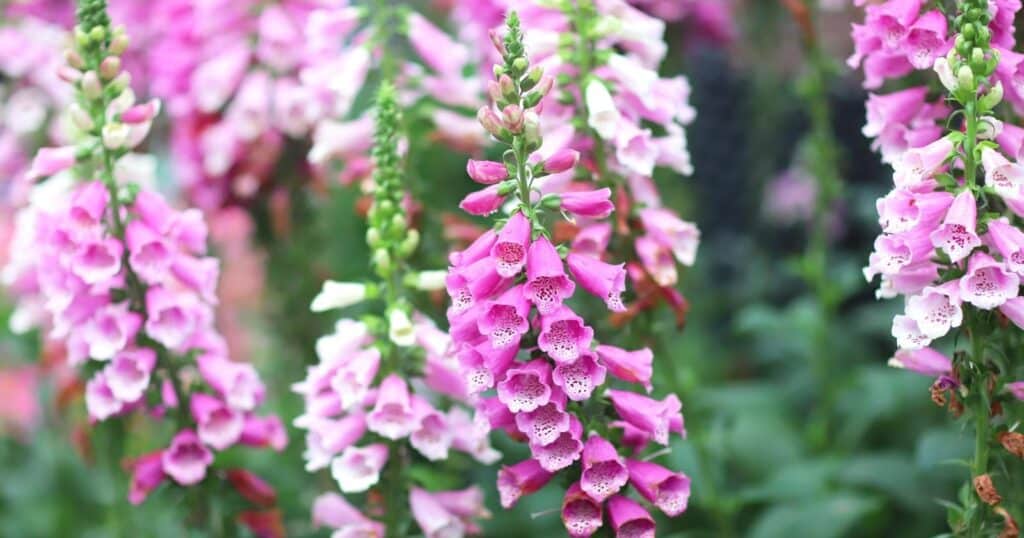
Scientific Name: Digitalis
- Plant Type: Perennial
- Origin: England
- Size: 24-48 inches
- Sun Needs: Partial Shade
- Hardiness Zones: 4 Through 10
Producing eye-catching, bell-shaped blooms, Foxglove offers a variety of colors and patterns to dress up any shady area, including the peachy-golden Goldcrest and the blushed pink Candy Mountain, with uniquely upward-facing cups.
While they propagate fuller, more bounteous blooms when they get a few hours of sun, they still do well in dappled shade and don’t require abundant water to survive.
Be aware that Foxglove is incredibly toxic, so avoid planting where children or animals have access to the flowers.
Gro-Low Sumac
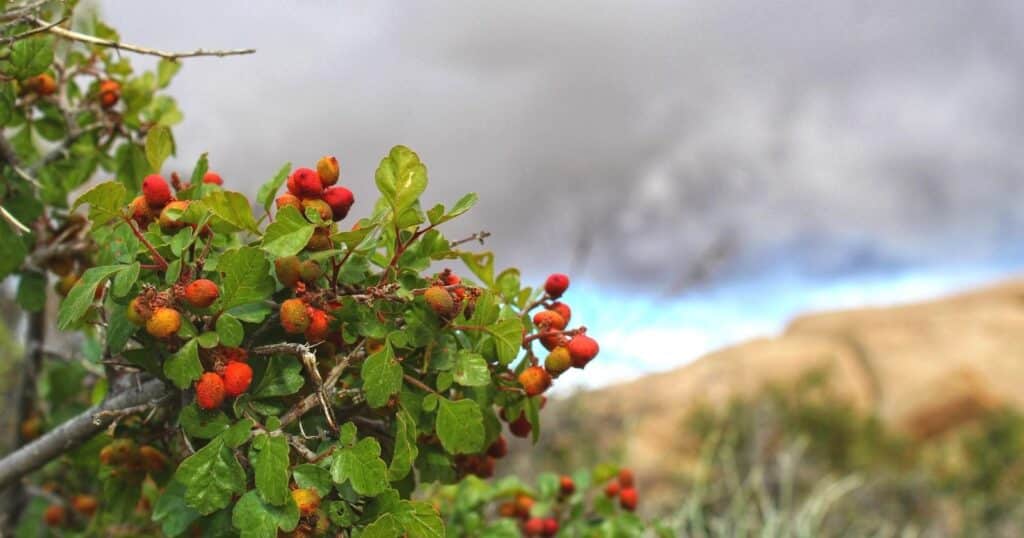
Scientific Name: Rhus aromatica
- Plant Type: Perennial
- Origin: Iran
- Size: 18 Inches
- Sun Needs: Full Sun – Partial Shade
- Hardiness Zones: 4 Through 9
This perennial shrub is ideal for ground cover and can extend over a large area. It’s a member of the cashew family and prefers subtropical climates.
Sumac is a reddish, scarlet color and features drooping leaves with fruit clusters.
Rhus aromatica can thrive in drought-prone and dry areas while also providing shade. When grown on a trellis or overhead pergola, this plant can offer a reprieve from the harsh sun.
Gro-Low Sumac can survive in shady areas and produce colorful fruits used as classic Mediterranean spices.
Sumac is popular for home remedies and in foods to enhance flavor.
Hellebore
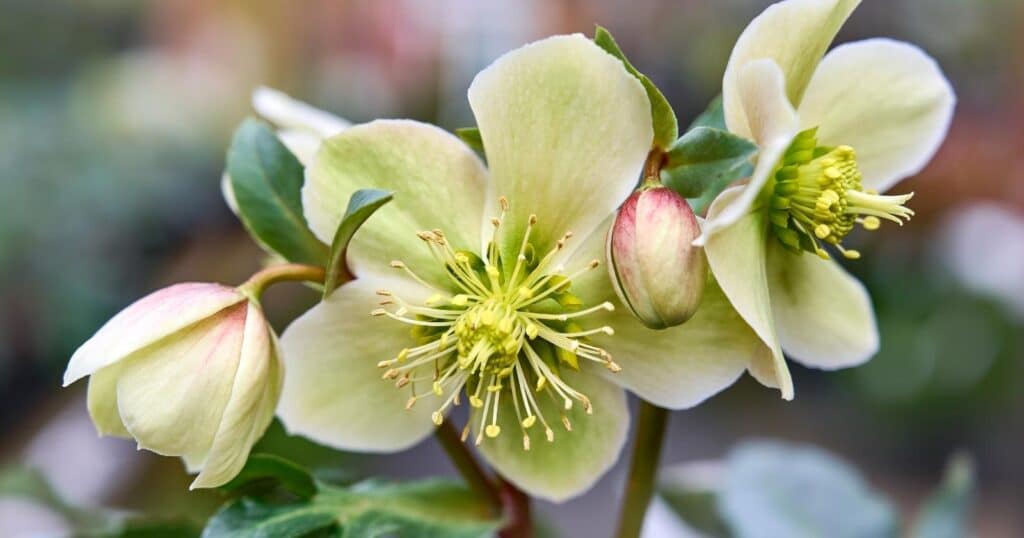
Scientific Name: Helleborus niger
- Plant Type: Perennial
- Origin: Europe
- Size: 18 Inches
- Sun Needs: Partial Shade
- Hardiness Zones: 6 Through 9
Hellebore or Christmas rose prefers semi-shade but can thrive in nearly any condition. This plant is heat tolerant and drought resistant, ideal for homes or gardens in subtropical areas.
A Hellebore plant has a set of leaves at its base that are a vibrant green color. The flowers grow inches above the foliage and are usually purple or reddish.
This plant will do well in the shade but will struggle to produce flowers when in too much shade for too long.
Hellebores do best in a location where the landscape is sloped because their flowers droop downward. The slope will enable the plant to conserve energy while maintaining its integrity.
Hosta
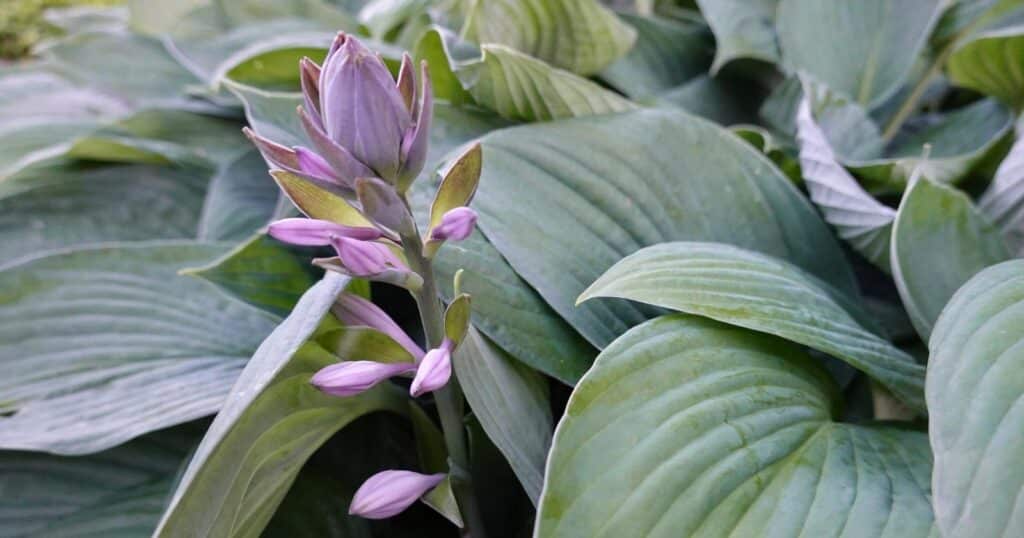
Scientific Name: Hosta sieboldiana
- Plant Type: Perennial
- Origin: Asia
- Size: 26 Inches
- Sun Needs: Partial Shade
- Hardiness Zones: 3 Through 9
Hosta plants, also known as Plantation Lilies, are perfect candidates to offer shade for a walkway and thrive in shady areas. This plant has a bushel of dark green leaves that provide plenty of shade for its roots, easily scorched in the sun.
Unlike other shrubby perennials, Hosta sieboldiana keeps its leaves above the ground, ideal for protecting a rock garden or succulent plantings. Hosta plants grow lavender or white flowers that poke out from long stalks.
This plant is easy to grow and can be ideal for those who do not have much time to dedicate to their garden but still desire abundant greenery.
Ivy-leaved Cyclamen
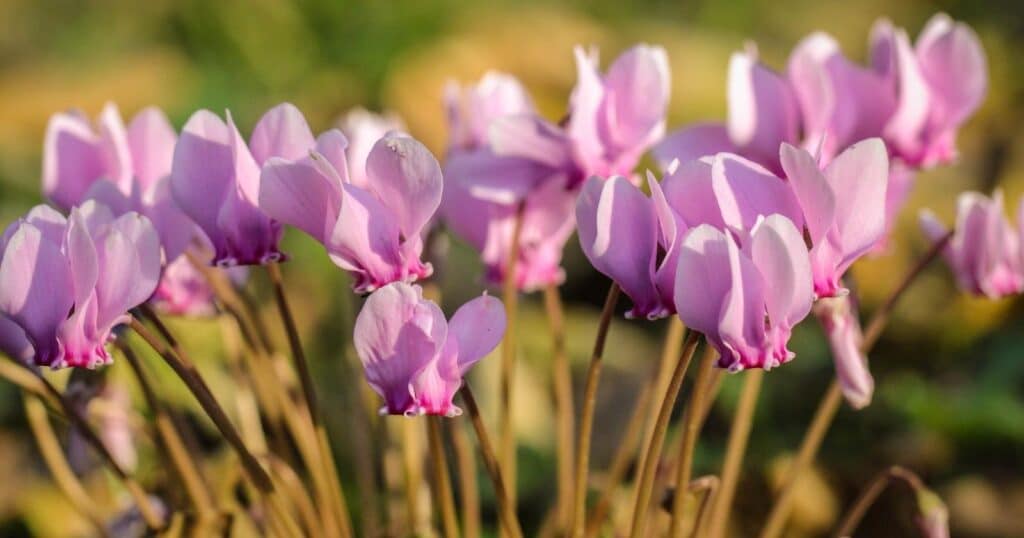
Scientific Name: Cyclamen hederifolium
- Plant Type: Perennial
- Origin: Mediterranean
- Size: 6 Inches
- Sun Needs: Partial Shade
- Hardiness Zones: 5 Through 9
Ivy-Leaved Cyclamen is an ideal plant for providing ground cover and shade to other garden plants or rocks, as one of its most attractive features is a bed of rich green leaves and flowers that grow upward on stalks. These flowers can come in purple, pink, lavender, and white.
It is a low-maintenance plant and prefers dry and drought-prone areas. However, this lush beauty may attract mice and squirrels to these leaves and flowers.
Look no further than Ivy-leaved Cyclamen for the perfect companion to rock gardens, wooded areas, or containers. Pet owners should beware, however, since this plant is toxic to dogs, cats, and horses.
Japanese Anemone
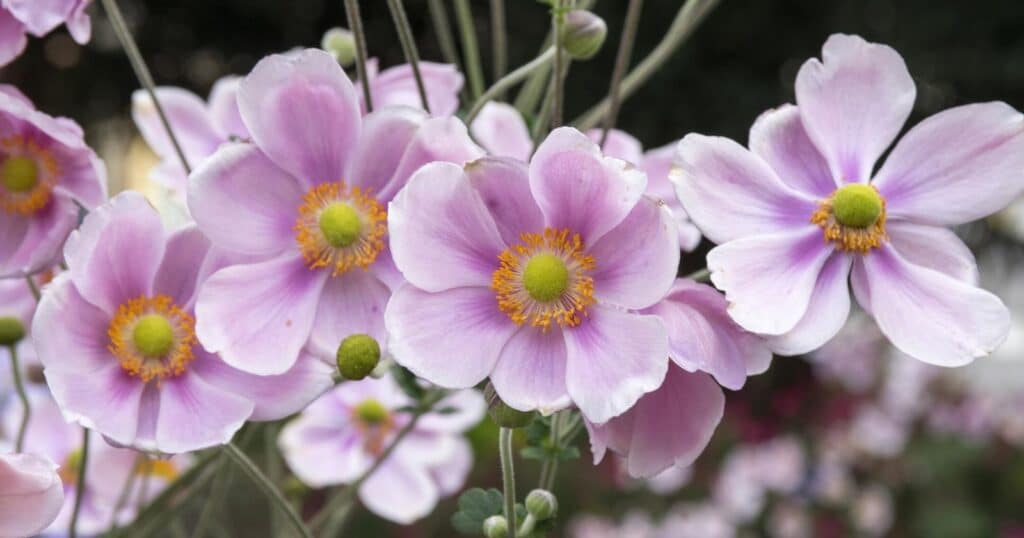
Scientific Name: Anemone hupehensis
- Plant Type: Perennials
- Origin: China
- Size: 4 Feet
- Sun Needs: Partial Shade
- Hardiness Zones: 4 Through 8
Japanese Anemone is native to China and has been cultivated in Japan for centuries. They acclimate happily to well-drained soil, drought-prone locations, and dry climates.
Anemone hupehensis blooms flat-petaled flowers in white, pink, and yellow shades with a cheery yellow center that attracts butterflies to partake of its pollen.
This plant is ideal for locations with partial shade but prefers some daily sunlight.
However, this plant may be toxic to pets and cause stomach irritation in humans.
Lady’s Mantle
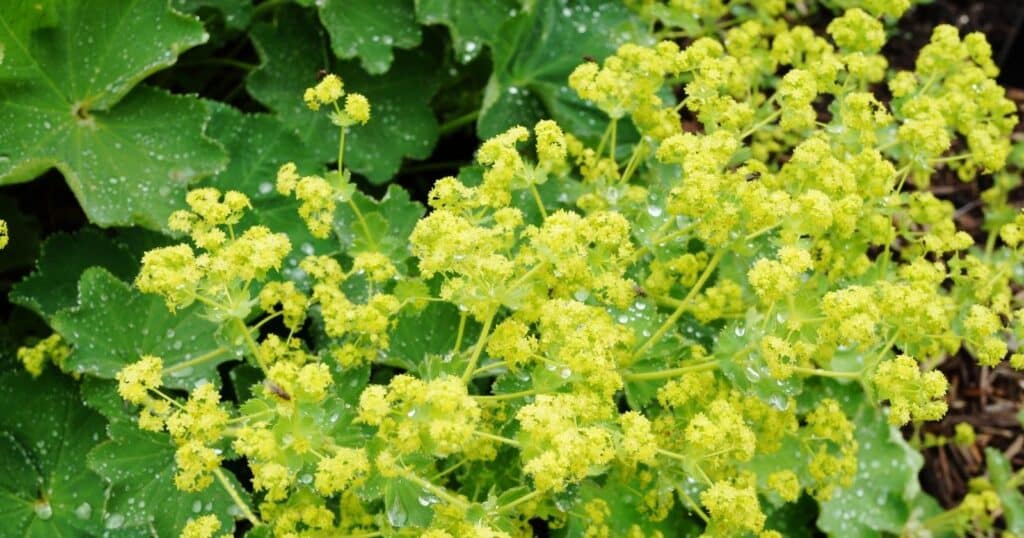
Scientific Name: Alchemilla mollis
- Plant Type: Perennial
- Origin: Europe
- Size: 24 Inches
- Sun Needs: Full Sun – Partial Shade
- Hardiness Zones: 3 Through 8
Lady’s Mantle is a ground cover plant popular in rock gardens and lining walkways.
Alchemilla mollis is also prominent in do-it-yourself products, thanks to its uniquely scalloped foliage and clusters of yellow blooms. It can be dried to make a fragrant and stunning addition to your home decor.
Although a Lady’s Mantle plant will thrive more in the sunshine, it can grow in the partial shade all the same.
Lily of the Valley
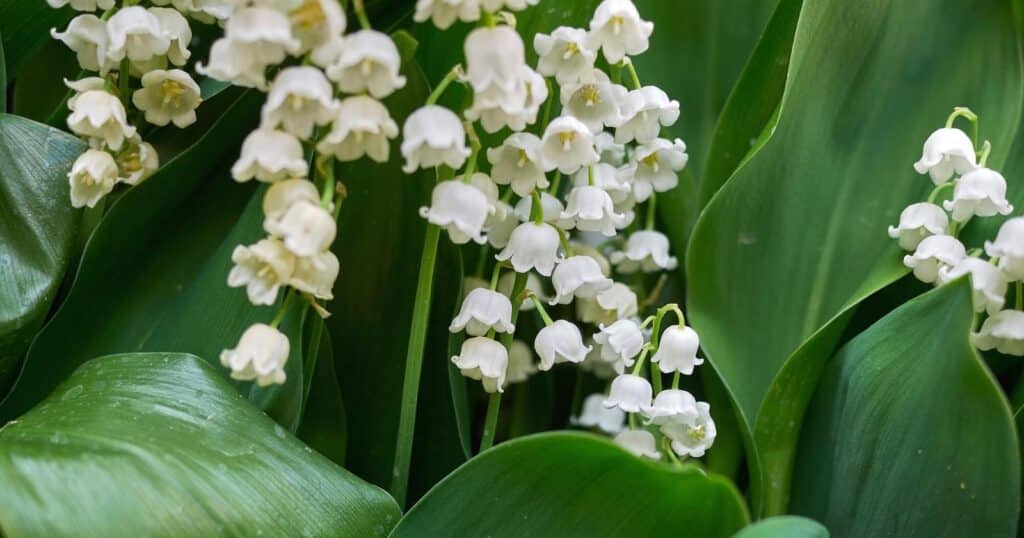
Scientific Name: Convallaria majalis
- Plant Type: Perennial
- Origin: Europe
- Size: 12 Inches
- Sun Needs: Partial Shade
- Hardiness Zones: 3 Through 9
Lily of the Valley is an ancient species that has been in existence since before 1,000 B.C., making it one of the oldest fragrant plants. It is ideal for drought-prone areas and prefers dry climates.
Convallaria majalis showcases vibrant green leaves and small, pearl-shaped fragrant flowers that elegantly droop downward.
To thrive, they require minimal maintenance, making them the ideal drought-tolerant shade plant for a natural or cottage garden.
Lilyturf
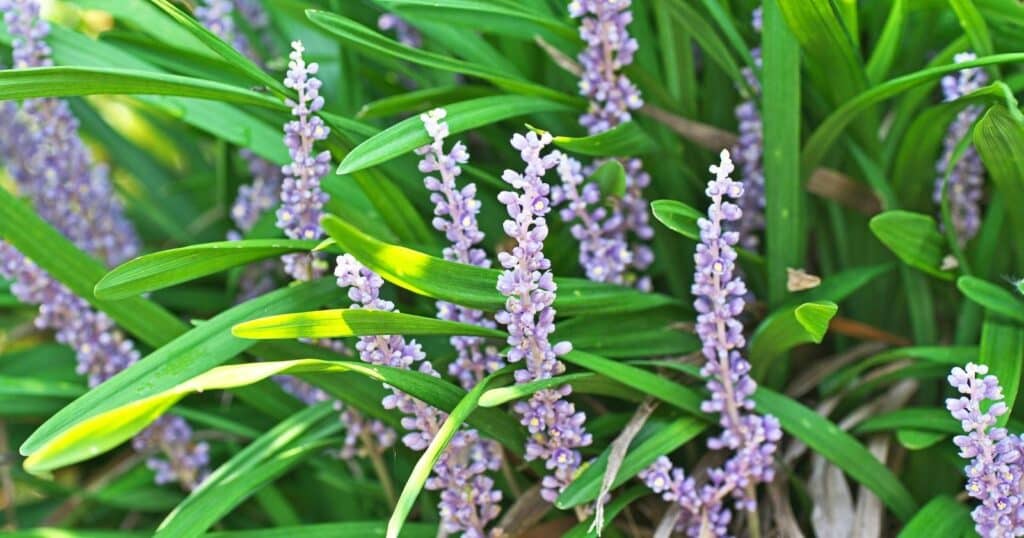
Scientific Name: Liriope muscari
- Plant Type: Perennial
- Origin: Asia
- Size: 12 Inches
- Sun Needs: Full Sun – Partial Shade
- Hardiness Zones: 5 Through 10
Lilyturf is a stunning and versatile plant popular with beginning gardeners who want greenery guaranteed to thrive. They produce blade-shaped, greenish-gray leaves with proud stalks of small, clustered purple flowers.
Lilyturf plants will happily root down in sand, gravel, and clay, and it does not require much sun. However, more flowers will bloom on a Lilyturf when it has more access to a sunny location.
This plant is drought resistant and can survive even when water is unavailable.
Lungwort
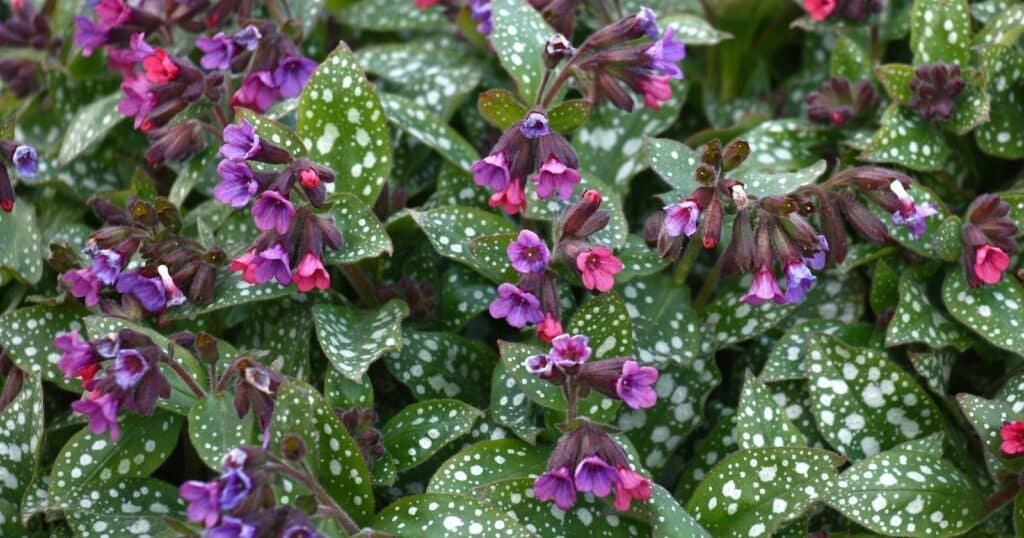
Scientific Name: Pulmonaria obscura
- Plant Type: Perennial
- Origin: Europe and Asia
- Size: 12 Inches
- Sun Needs: Partial Sun
- Hardiness Zones: 3 Through 8
A Lungwort is a stunning and hardy plant that does not require much water, sun, or care. This plant functioned as a relieving agent for lung conditions in ancient times, thus giving it its name.
This small plant can have dozens of blue and purple flowers that sit atop fuzzy leaves.
Fuzzy leaves are naturally resistant to deer and rabbits, meaning you will not have to be concerned about these critters sneaking into your garden and making a meal of your Pulmonaria obscura.
Maidenhair Fern
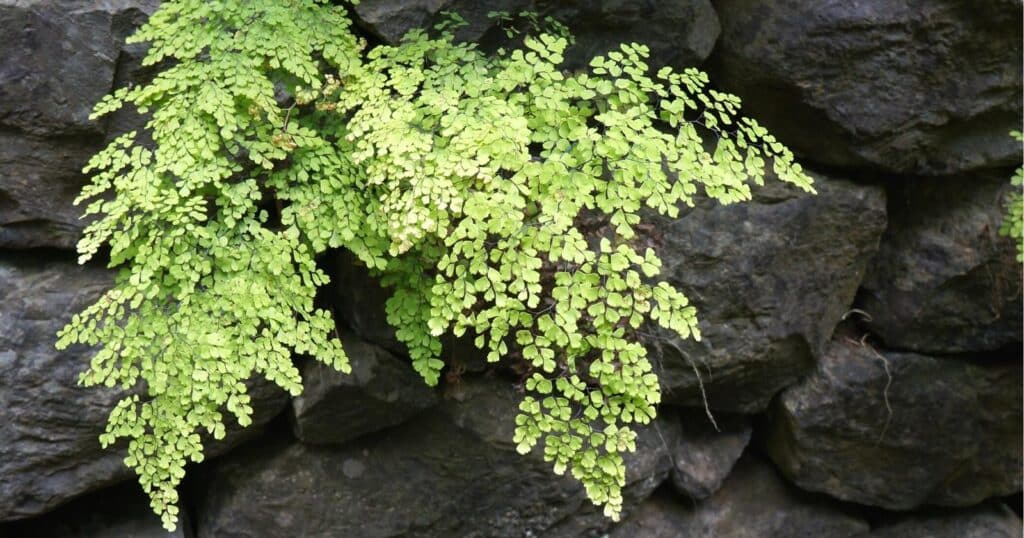
Scientific Name: Adiantum capillus-veneris
- Plant Type: Perennial
- Origin: South America
- Size: 2 Feet
- Sun Needs: Partial Shade
- Hardiness Zones: 8 Through 10
This vining plant is hardy and can survive in difficult, dry, and drought-prone locations. This plant will vine out of its container and creep along the ground. However, Maidenhair Ferns do enjoy well-drained and nutrient-rich soil.
Maidenhair Ferns are ideal for an indoor garden and are often used as a contemporary decorative item.
With a light and vibrant green color, a Maidenhair Fern adds a pop of color to any room, garden, or walkway.
Pheasant Grass
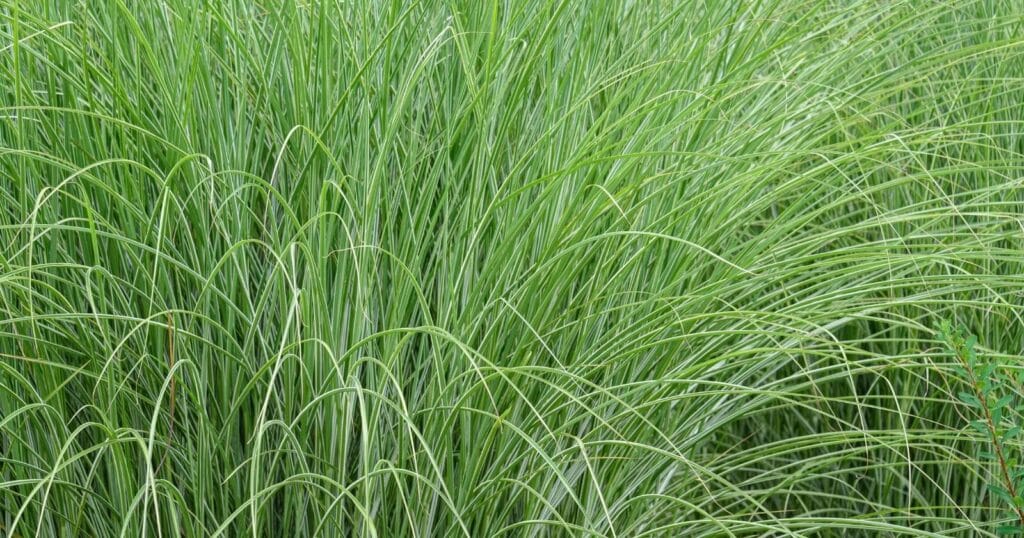
Scientific Name: Anemanthele lessoniana
- Plant Type: Perennial
- Origin: New Zealand
- Size: 24 Inches
- Sun Needs: Full Sun – Partial Shade
- Hardiness Zones: 8
Unlike many other types of grasses, Pheasant Grass is not invasive, although it will self-sow and reproduce on its own.
This plant is ideal for arid climates because it does not need much water.
Pheasant Grass offers plentiful shade and is often used for bordering walkways and front lawns. This grass can also be grown in containers.
Red Barrenwort
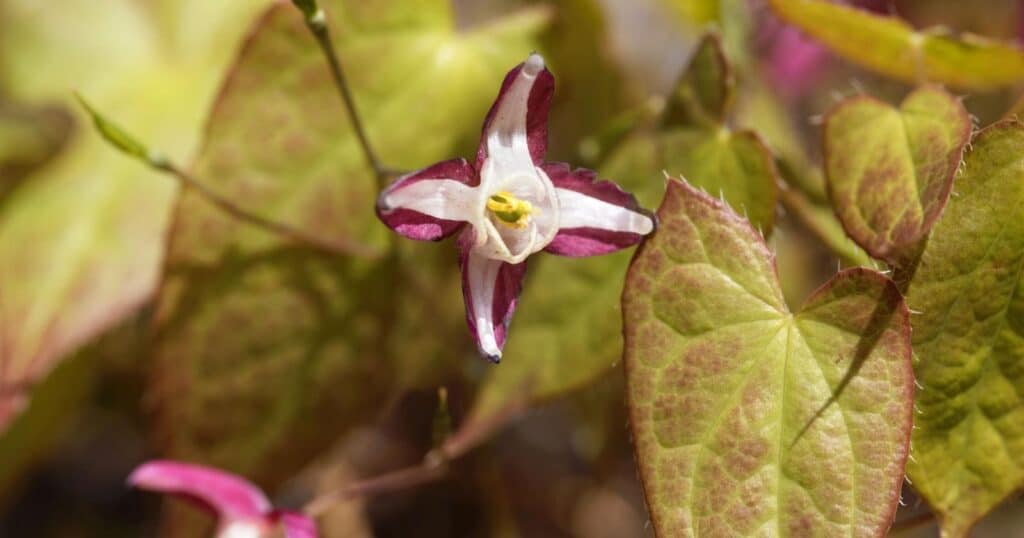
Scientific Name: Epimedium x rubrum
- Plant Type: Perennial
- Origin: Europe
- Size: 15 Inches
- Sun Needs: Full Shade
- Hardiness Zones: 4 Through 8
Red Barrenwort blooms with gorgeous reddish-pink flowers that grow in bent stalks above a lush bed of green leaves below. These plants are perennials, but they multiply quickly.
Red Barrenwort grows best in full shade, making it even more resistant to droughts as sunlight scorching the plant will be less of an issue.
Siberian Bugloss
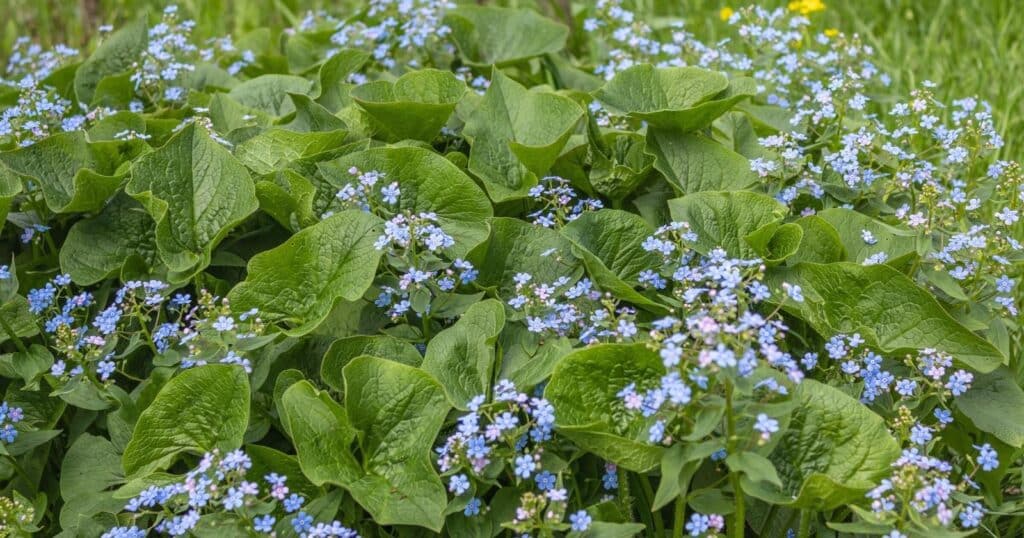
Scientific Name: Brunnera macrophylla
- Plant Type: Perennial
- Origin: Europe
- Size: 18 Inches
- Sun Needs: Partial Shade
- Hardiness Zones: 3 Through 8
There may be nothing more attractive in a home garden than the blue color of the Siberian Bugloss plant.
Below vibrant blue clusters of up to eight tiny flowers are a bed of rich green leaves. The leaves of this plant are sometimes more prominent than the clusters of flowers.
This plant can survive in full sun but may need more water to thrive. However, this plant will thrive in partial shade with little water.
Solomon’s Seal
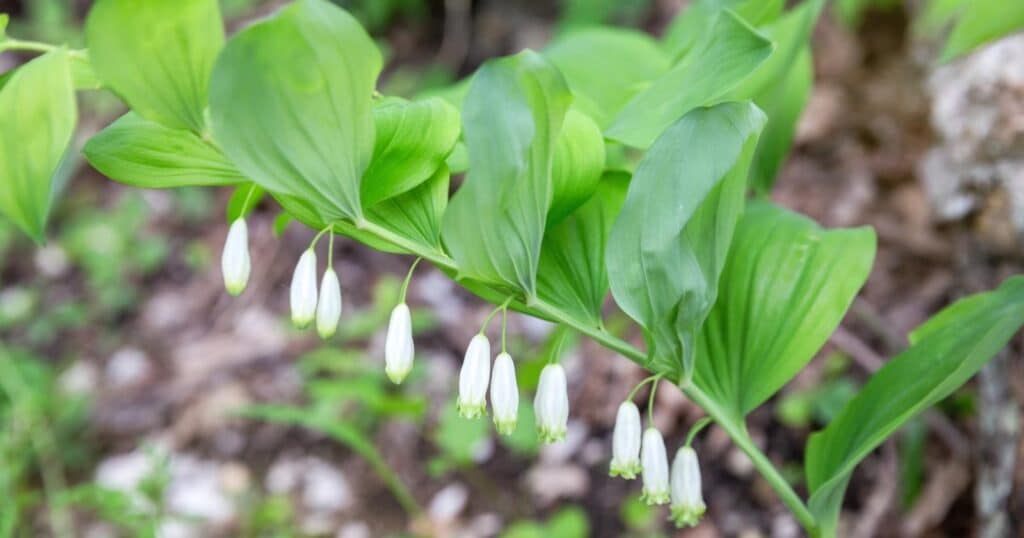
Scientific Name: Polygonatum odoratum
- Plant Type: Perennial
- Origin: Japan
- Size: 7 Feet
- Sun Needs: Partial Shade
- Hardiness Zones: 3 Through 9
Solomon’s Seal is a tall plant that grows small, blue fruits and has several green leaves that stem from its stalks. This plant prefers shady and wooded areas and produces flowers of various colors, including white, pink, or green.
While this plant is pretty, it has toxic properties for humans and animals.
Snowdrops
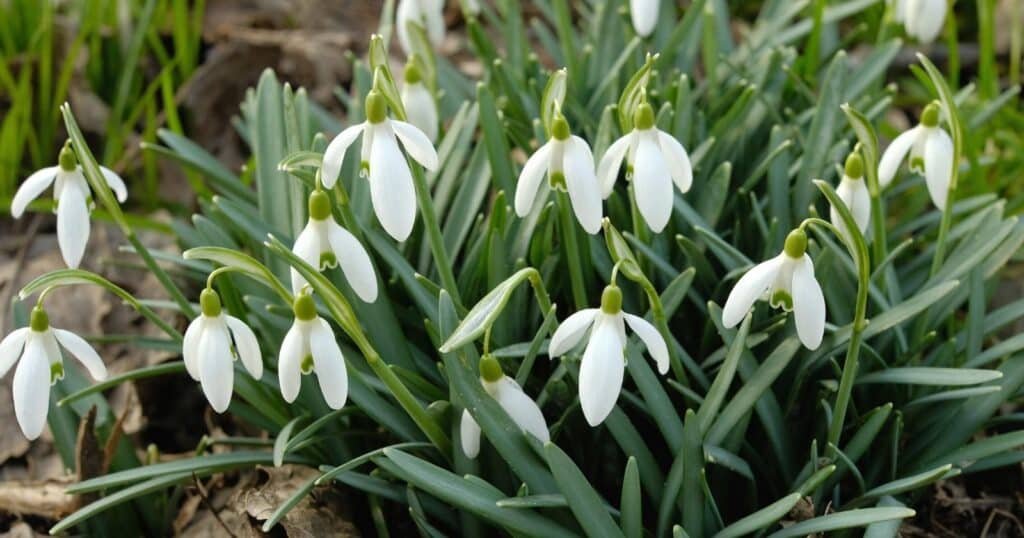
Scientific Name: Galanthus
- Plant Type: Perennial
- Origin: Europe and the Middle East
- Size: 6 Inches
- Sun Needs: Full Sun-Partial Shade
- Hardiness Zones: 3 Through 8
Snowdrops are similar to Lily of the Valleys but are much smaller. Despite its minuscule size, this plant can survive in both cold and hot climates, though it will not do well overwintering in warm conditions.
It is also drought-resistant, heat resistant, and requires little maintenance.
This plant grows on a rich green stalk and has white flowers that droop downward at the end of the stem.
Their name comes from the fact that they are often seen poking through the snow at the first hint of spring.
St. John’s Wort
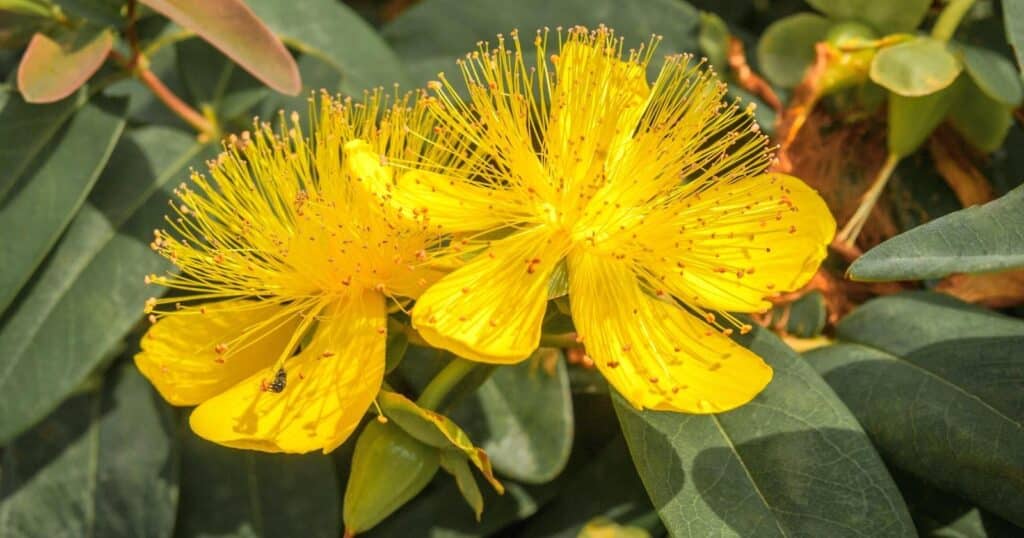
Scientific Name: Hypericum calycinum
- Plant Type: Perennial
- Origin: Europe
- Size: 6 Feet
- Sun Needs: Partial Shade
- Hardiness Zones: 5 Through 9
St. John’s Wort has a yellow flower with tendrils against its petals. This plant prefers shade but will thrive in sunlight, as well. This plant is not picky about the soil it uses, but it must be well-drained.
St. John’s Wort has been used for its medicinal properties since the middle ages in Europe.
Sweet Woodruff
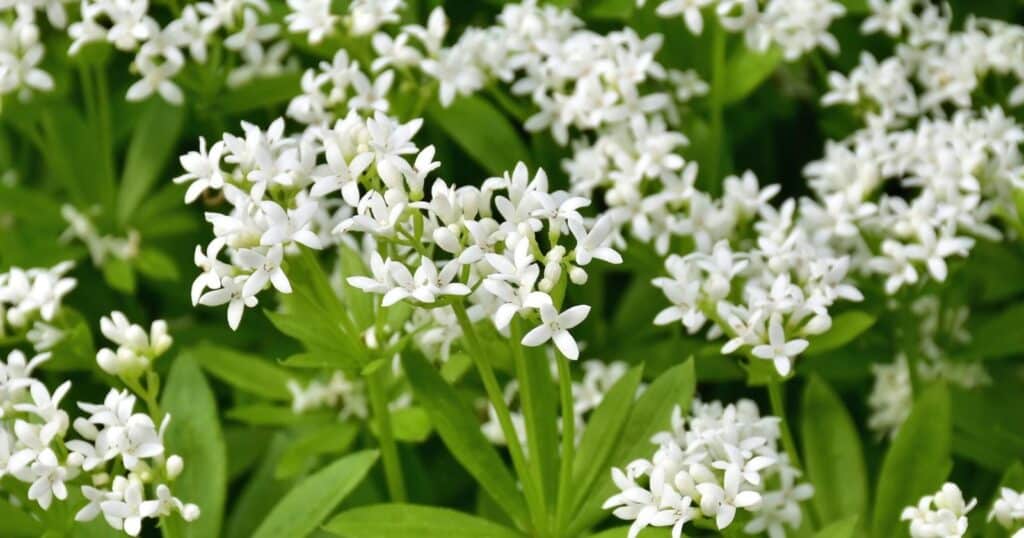
Scientific Name: Galium odoratum
- Plant Type: Perennial
- Origin: Europe and Africa
- Size: 12 Inches
- Sun Needs: Partial Shade
- Hardiness Zones: 4 Through 8
Technically, Sweet Woodruff is a herb that grows small white flowers, making it a lovely drought tolerant shade plant for an herb garden. It also produces an attractively sweet scent.
This plant prefers shade but will not wither in the sun. Many gardeners use Sweet Woodruff to sweeten the air in a shaded garden.
Sweet Woodruff was used to treat wounds and cuts in ancient Europe, Africa, and Siberia.
Yellow Archangel
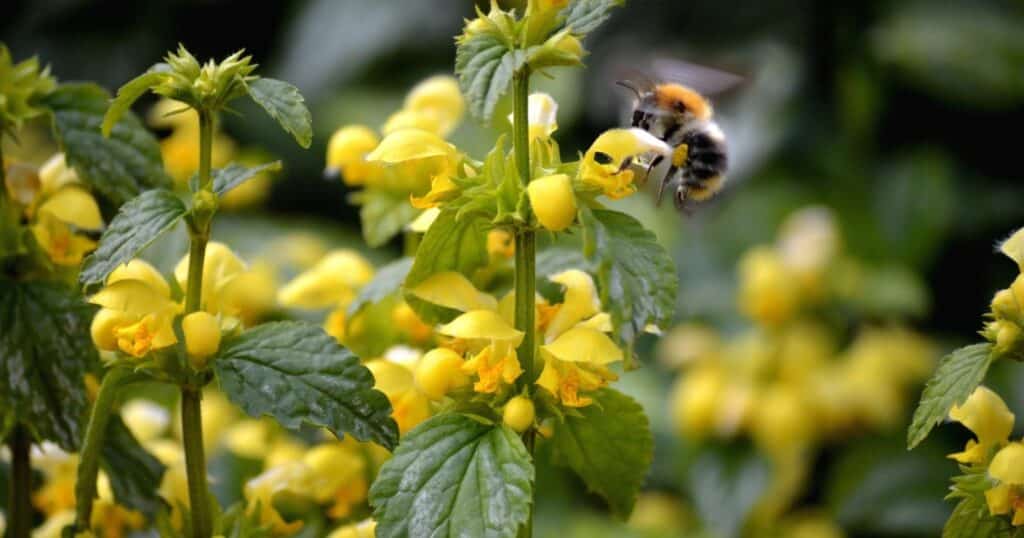
Scientific Name: Lamiastrum galeobdolon
- Plant Type: Perennial
- Origin: Europe and Asia
- Size: 10 Inches
- Sun Needs: Part Sun
- Hardiness Zones: 4 Through 9
This drought-resistant plant is a low-growing perennial and contains a ground-level bed of leaves. The flowers on this plant are yellow and grow upward on stalks. They bloom in multiple tiers and prefer partial shade to thrive.
Silver markings are common on the leaves of a Yellow Archangel, adding visual interest to otherwise monochromatic foliage.
Yellow Archangel is highly competitive and can overtake a shady bed if not controlled by a firm hand. Because of this tendency, it’s illegal to buy or sell Lamiastrum galeobdolon in Washington state.
Yellow Corydalis
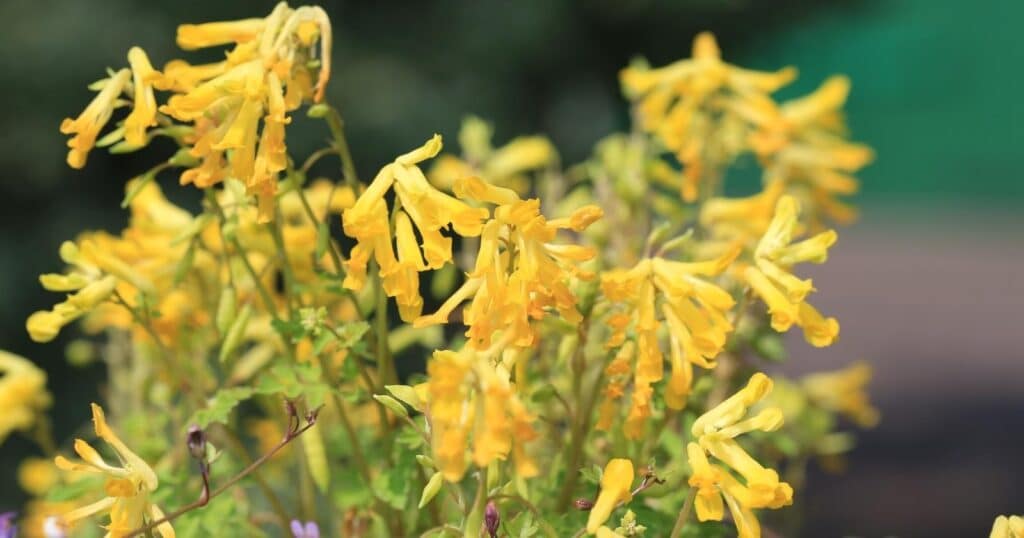
Scientific Name: Corydalis lutea
- Plant Type: Perennial
- Origin: Europe
- Size: 15 Inches
- Sun Needs: Full Sun – Partial Shade
- Hardiness Zones: 5 Through 7
Yellow Corydalis is an example of flowers blooming in even the most unfavorable conditions, as it can grow out of the tiniest crevasses in pathways, walkways, or brick walls.
This plant is a resilient perennial native to Europe and can make a great addition to walkways, home gardens, or rock gardens.
The flowers from a Yellow Corydalis are vibrant and shaped like a long bell.
Wrap Up
Finding the perfect drought tolerant shade plants can be challenging but not impossible. While you may not have access to the variety afforded in more favorable conditions, the determined home gardener still has many options.
Drought tolerant shade plants are easy to manage and help companion plants’ roots cool, further assisting in the survival of their bedmates.
Although ivy or other low-lying plants will not provide shade for humans, they will shade their roots or the roots of nearby plants, making them ideal for maintaining moisture levels in drought-prone areas.

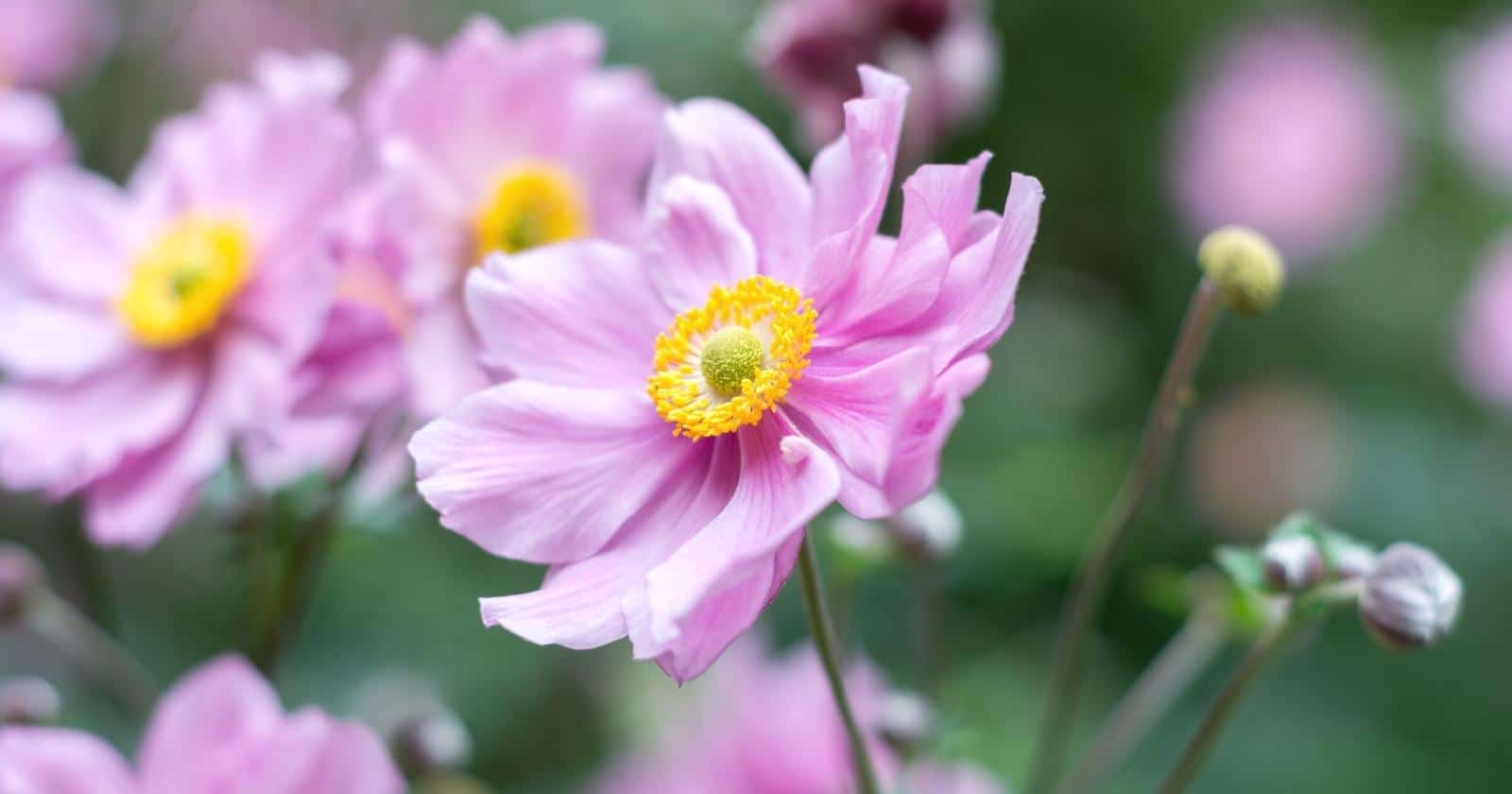
Leave a comment